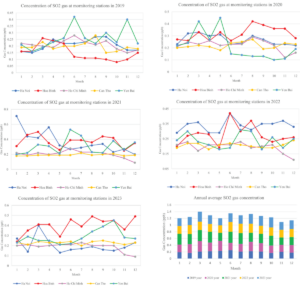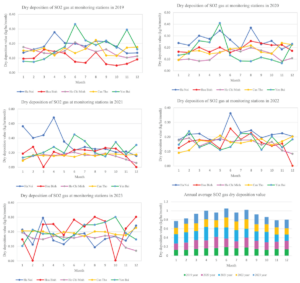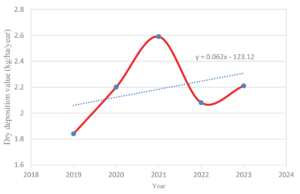Trend of SO2 Gas Dry Deposition in Vietnam
Introduction
The intricate relationship between atmospheric deposition and soil health has been a focus of extensive research in recent years. Sulfur dioxide (SO2) dry deposition, in particular, has profound implications for soil ecosystems, agricultural productivity, and environmental sustainability. The study titled “Trend of SO2 Gas Dry Deposition in Vietnam” sheds light on the patterns and trends of SO2 dry deposition in Vietnam over the past five years, providing valuable insights into its impact on Soil Science.
This blog delves into the findings of the study, exploring the methodologies used, results obtained, and their broader implications for Soil Science and environmental policy.
Understanding SO2 Dry Deposition
What is SO2 Dry Deposition?
SO2 dry deposition refers to the process by which sulfur dioxide gas is transferred from the atmosphere to terrestrial surfaces, including soil. Unlike wet deposition, which occurs through precipitation, dry deposition happens when gaseous or particulate matter settles on surfaces due to gravitational or aerodynamic forces.
 Figure 1: Changing of SO2 concentration at stations in Vietnam.
Figure 1: Changing of SO2 concentration at stations in Vietnam.
Key factors influencing SO2 dry deposition include:
Meteorological Conditions: Wind speed, temperature, and humidity.
Surface Characteristics: Soil type, vegetation cover, and land use.
Chemical Properties: Interaction with other atmospheric compounds.
Relevance to Soil Science
SO2 dry deposition alters soil chemistry, often lowering pH levels and increasing sulfate concentrations. This can:
Affect microbial activity and nutrient cycling.
Impair plant growth and crop yield.
Accelerate soil degradation in vulnerable ecosystems.
Findings from the Study
Methodology
The study utilized an inferential approach to estimate SO2 dry deposition, combining atmospheric concentration data with deposition velocity calculations. Key equations included:
Where:
= Dry deposition of SO2
= Deposition velocity
= Atmospheric concentration of SO2
Results
Regional Variations
Northern Vietnam exhibited higher SO2 dry deposition levels compared to Southern regions.
Hanoi recorded the highest deposition values from 2019 to 2022, while Hoa Binh surpassed it in 2023 with 2.45 kg/ha/year.
Seasonal Patterns
Summer and autumn (April to August) experienced peak deposition rates due to higher temperatures and lower humidity.
Winter and spring showed reduced deposition, influenced by increased rainfall and lower temperatures.
Temporal Trends
The overall trend indicated an increase in SO2 dry deposition from 1999 to 2023, with a sharp rise until 2021 followed by slight fluctuations.
These findings highlight the dynamic nature of SO2 dry deposition and its significant implications for Soil Science.
 Figure 2: Changing of SO2 gas dry deposition at stations in Vietnam.
Figure 2: Changing of SO2 gas dry deposition at stations in Vietnam.
Implications for Soil Science
Impact on Soil Chemistry
SO2 dry deposition contributes to soil acidification by forming sulfuric acid upon interaction with moisture. This process:
Depletes essential nutrients such as calcium and magnesium.
Mobilizes toxic elements like aluminum, posing risks to plant health.
Effects on Agricultural Productivity
The study underscores the potential for reduced crop yields in regions with high SO2 deposition. Acidified soils can:
Inhibit root development.
Reduce nutrient uptake efficiency.
Alter soil microbial communities essential for plant growth.
Long-Term Environmental Consequences
Prolonged SO2 deposition can lead to irreversible soil degradation, impacting:
Biodiversity in terrestrial ecosystems.
Carbon sequestration capacity of soils.
Water quality due to runoff of acidified soils into aquatic systems.
Mitigation Strategies
Policy Interventions
Enforcing stricter emission controls on industrial activities.
Promoting cleaner energy sources to reduce SO2 emissions.
Soil Management Practices
Liming acidic soils to neutralize pH levels.
Implementing crop rotation and organic amendments to enhance soil resilience.
Monitoring and Research
Expanding the network of monitoring stations for real-time data.
Conducting longitudinal studies to assess long-term impacts on Soil Science.

Figure 3: Trend of SO2 gas dry deposition in 1999-2023 year.
Conclusion
The study “Trend of SO2 Gas Dry Deposition in Vietnam” provides critical insights into the patterns and impacts of SO2 deposition on soil ecosystems. By understanding these dynamics, policymakers, researchers, and agricultural practitioners can develop targeted strategies to mitigate its adverse effects.
The recurring keyword “Soil Science” underscores the importance of integrating atmospheric and soil studies to address environmental challenges effectively. As we advance our understanding, such interdisciplinary approaches will be key to ensuring sustainable development and ecological balance.
Tags: Soil Science, SO2 Dry Deposition, Environmental Policy, Acid Rain, Atmospheric Deposition, Agricultural Impact, Soil Chemistry, Vietnam, Climate Change, Sustainable Agriculture
